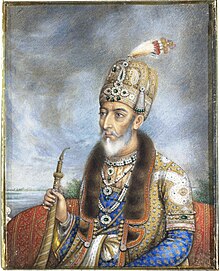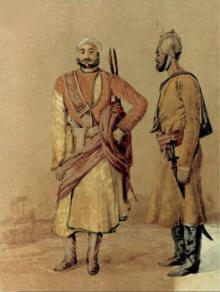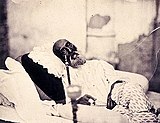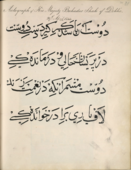Bahadur Shah Zafar
| Bahadur Shah Zafar | |||||||||||||
|---|---|---|---|---|---|---|---|---|---|---|---|---|---|
| King of Delhi Padishah Shahanshah-e-Hindustan Emperor of India | |||||||||||||
 Portrait of Bahadur Shah Zafar II, c. 1850 | |||||||||||||
| Emperor of Hindustan | |||||||||||||
| Reign | 28 September 1837 – 21 September 1857 | ||||||||||||
| Coronation | 29 September 1837 | ||||||||||||
| Predecessor | Akbar II | ||||||||||||
| Successor | Empire abolished | ||||||||||||
| Born | 24 October 1775 Shahjahanabad, Mughal Empire (present-day Old Delhi, India) | ||||||||||||
| Died | 7 November 1862 (aged 87) Rangoon, Burma Province, British India (present-day Yangon, Myanmar) | ||||||||||||
| Burial | 7 November 1862 Rangoon, Burma | ||||||||||||
| Spouse | |||||||||||||
| Issue | Mirza Dara Bakht, Mirza Mughal, Mirza Fath-ul-Mulk Bahadur, Mirza Khizr Sultan, Mirza Jawan Bakht, Mirza Shah Abbas, Mirza Abu Bakr Mirza Ulugh Tahir | ||||||||||||
| |||||||||||||
| House | House of Babur | ||||||||||||
| Dynasty | Timurid dynasty | ||||||||||||
| Father | Akbar Shah II | ||||||||||||
| Mother | Lal Bai[3] | ||||||||||||
| Religion | Sunni Islam (Hanafi) | ||||||||||||
| Imperial Seal |  | ||||||||||||
| Military career | |||||||||||||
| Battles / wars | Indian Rebellion of 1857 | ||||||||||||
Bahadur Shah II (born Mirza Abu Zafar Siraj-ud-din Muhammad (24 October 1775 – 7 November 1862), usually referred to by his poetic title Bahadur Shah Zafar (Persian pronunciation: [ba.hɑː.ˈduɾ ʃɑːh za.ˈfaɾ]; Zafar lit. 'Victory'), was the twentieth and last Mughal emperor and a Hindustani poet. He was the second son and the successor to his father, Akbar II, who died in 1837.[4] He was a titular Emperor, as the Mughal Empire existed in name only and his authority was limited only to the walled city of Old Delhi (Shahjahanbad). Following his involvement in the Indian Rebellion of 1857, the British deposed him and exiled him to Rangoon in British-controlled Burma in late 1858, after convicting him on several charges. The title of Empress of India was subsequently assumed by Queen Victoria.
Bahadur Shah Zafar's father, Akbar II, had been imprisoned by the British and he was not his father's preferred choice as his successor. One of Akbar Shah's queens pressured him to declare her son, Mirza Jahangir, as his successor.[citation needed] However, the East India Company exiled Jahangir after he attacked their resident in the Red Fort,[4] paving the way for Bahadur Shah to assume the throne.
Reign
[edit]
| Mughal emperors | ||||||||||||||||||||||||||||||||||||||||||||||
|---|---|---|---|---|---|---|---|---|---|---|---|---|---|---|---|---|---|---|---|---|---|---|---|---|---|---|---|---|---|---|---|---|---|---|---|---|---|---|---|---|---|---|---|---|---|---|
|
||||||||||||||||||||||||||||||||||||||||||||||

Bahadur Shah Zafar ruled over a Mughal Empire that had by the early 19th century been reduced to only the city of Delhi and the surrounding territory as far as Palam.[5] The Maratha Empire had brought an end to the Mughal Empire in the Deccan during the 18th century and the regions of India formerly under Mughal rule had either been absorbed by the Marathas or had declared independence and become smaller kingdoms.[6] The Marathas installed Shah Alam II in the throne in 1772, under the protection of the Maratha general Mahadaji Shinde and maintained suzerainty over Mughal affairs in Delhi. The East India Company became the dominant political and military power in mid-nineteenth century India. Outside the region controlled by the company, hundreds of kingdoms and principalities fragmented their land. The emperor was respected by the company, who provided him with a pension. The emperor permitted the company to collect taxes from Delhi and maintain a military force in it. Zafar never had any interest in statecraft or had any "imperial ambition".[citation needed] After the Indian Rebellion of 1857, the British exiled him from Delhi.
Bahadur Shah Zafar was a noted Urdu poet, having written a number of Urdu ghazals. While some part of his opus was lost or destroyed during the Indian Rebellion of 1857, a large collection did survive, and was compiled into the Kulliyyat-i-Zafar. The court that he maintained was home to several renowned Urdu scholars, poets and writers including Mirza Ghalib, Daagh Dehlvi, Momin Khan Momin, and Mohammad Ibrahim Zauq (who was also Bahadur Shah Zafar's mentor).
After Zafar's defeat, he said:[7]
ہندوں میں بُو رہے گی جب تلک ایمان کی
Hinduyoñ meñ bū rahe gī jab talak īmān kī
As long as there remains the scent of Iman in the hearts of Hindus (Indians),
تختِ لندن تک چلے گی تیغِ ہندوستان کی
Takht-i-Landan tak chale gī tegh-i-Hindostān kī.
So long shall the sword of Hindustan flash before the throne of London.
1857 Rebellion
[edit]As the Indian Rebellion of 1857 spread, Sepoy regiments reached the Mughal Court at Delhi.
On 12 May 1857, Zafar held his first formal audience in several years.[8] It was attended by several sepoys who were described as treating him "familiarly or disrespectfully".[9] When the sepoys first arrived at Bahadur Shah Zafar's court, he asked them why they had come to him, because he had no means of maintaining them. Bahadur Shah Zafar's conduct was indecisive. However, he yielded to the demands of the sepoys when he was told that they would not be able to win against the East India Company without him.[10]
On 16 May, sepoys and palace servants killed fifty-two Europeans who were prisoners of the palace and who were discovered hiding in the city. The executions took place under a peepul tree in front of the palace, despite Zafar's protests. The aim of the executioners was to implicate him in the killings.[11] Once he had joined them, Bahadur Shah II took ownership for all the actions of the mutineers. Though dismayed by the looting and disorder, he gave his public support to the rebellion. It was later believed that Bahadur Shah was not directly responsible for the massacre, but that he may have been able to prevent it, and he was therefore considered a consenting party during his trial.[10]
The administration of the city and its new occupying army was described as "chaotic and troublesome", which functioned "haphazardly". The Emperor nominated his eldest son, Mirza Mughal, as the commander in chief of his forces. However, Mirza Mughal had little military experience and was rejected by the sepoys. The sepoys did not have any commander since each regiment refused to accept orders from someone other than their own officers. Mirza Mughal's administration extended no further than the city. Outside Gujjar herders began levying their own tolls on traffic, and it became increasingly difficult to feed the city.[12]
During the Siege of Delhi when the victory of the British became certain, Zafar took refuge at Humayun's Tomb, in an area that was then at the outskirts of Delhi. Company forces led by Major William Hodson surrounded the tomb and Zafar was captured on 20 September 1857. The next day, Hodson shot his sons Mirza Mughal and Mirza Khizr Sultan, and grandson Mirza Abu Bakht under his own authority at the Khooni Darwaza, near the Delhi Gate and declared Delhi to be captured. Bahadur Shah himself was taken to his wife's haveli, where he was treated disrespectfully by his captors. When brought news of the executions of his sons and grandson, the former emperor was described as being so shocked and depressed that he was unable to react.[13]
Trial
[edit]The trial was a consequence of the Sepoy Mutiny and lasted for 21 days, had 19 hearings, 21 witnesses and over a hundred documents in Persian and Urdu, with their English translations, were produced in the court.[14] At first the trial was suggested to be held at Calcutta, the place where Directors of East India company used to their sittings in connection with their commercial pursuits. But instead, the Red Fort in Delhi was selected for the trial.[15] It was the first case to be tried at the Red Fort.[16][unreliable source?]
Zafar was tried and charged on four counts:[17]
- Aiding and abetting the mutinies of the troops
- Encouraging and assisting divers persons in waging war against the British Government
- Assuming the sovereignty of Hindostan
- Causing and being accessory to the murder of the Christians.
— Proceedings of the April 1858 Trial of Bahadur Shah Zafar 'King of Delhi'
On the 20th day of the trial Bahadur Shah II defended himself against these charges.[14] Bahadur Shah, in his defense, stated his complete haplessness before the will of the sepoys. The sepoys apparently used to affix his seal on empty envelopes, the contents of which he was absolutely unaware. While the emperor may have been overstating his impotence before the sepoys, the fact remains that the sepoys had felt powerful enough to dictate terms to anybody.[18] The eighty-two-year old poet-king was harassed by the mutineers and was neither inclined to nor capable of providing any real leadership. Despite this, he was the primary accused in the trial for the rebellion.[16]
Hakim Ahsanullah Khan, Zafar's most trusted confidant and both his Prime Minister and personal physician, had insisted that Zafar did not involve himself in the rebellion and had surrendered himself to the British. But when Zafar ultimately did this, Hakim Ahsanullah Khan betrayed him by providing evidence against him at the trial in return for a pardon for himself.[19]
Respecting Hodson's guarantee on his surrender, Zafar was not sentenced to death but exiled to Rangoon, Burma.[14] His wife Zeenat Mahal and some of the remaining members of the family accompanied him. At 4 am on 7 October 1858, Zafar along with his wives, two remaining sons began his journey towards Rangoon in bullock carts escorted by 9th Lancers under command of Lieutenant Ommaney.[20]
Death
[edit]In 1862, at the age of 87, he reportedly acquired an illness. In October, his condition deteriorated. He was "spoon-fed on broth" but he found that difficult too by 3 November.[21] On 6 November, the British Commissioner H.N. Davies recorded that Zafar "is evidently sinking from pure desuetude and paralysis in the region of his throat". To prepare for his death Davies commanded for the collection of lime and bricks and a spot was selected at the "back of Zafar's enclosure" for his burial. Zafar died on Friday, 7 November 1862 at 5 am. Zafar was buried at 4 pm near the Shwedagon Pagoda at 6 Ziwaka Road, near the intersection with Shwedagon Pagoda road, Yangon. The shrine of Bahadur Shah Zafar Dargah was built there after recovery of his tomb on 16 February 1991.[22][23] Davies commenting on Zafar, described his life to be "very uncertain".
Family and descendants
[edit]

Bahadur Shah Zafar had four wives and numerous concubines. His wives were:[24]
- Begum Ashraf Mahal
- Begum Akhtar Mahal
- Begum Zeenat Mahal
- Begum Taj Mahal
He had twenty two sons including:[25]
- Mirza Dara Bakht Miran Shah (1790–1841)
- Mirza Muhammed Shahrukh Bahadur
- Mirza Kayumar Bahadur
- Mirza Fath-ul-Mulk Bahadur[26] (alias Mirza Fakhru) (1816–1856)
- Mirza Muhammad Quwaish Bahadur
- Mirza Mughal (1817–1857)
- Mirza Quraish Shikoh (1820–c. 1889)
- Mirza Farkhanda Shah Bahadur
- Mirza Khizr Sultan (1834–1857)
- Mirza Bakhtavar Shah Bahadur
- Mirza Sohrab Hindi Bahadur
- Mirza Abu Nasr
- Mirza Muhammad Bahadur
- Mirza Abdullah
- Mirza Kuchak Sultan
- Mirza Abu Bakr (1837–1857)
- Mirza Jawan Bakht (1841–1884)
- Mirza Shah Abbas (1845–1910)
He had at least thirty-two daughters including:
- Rabeya Begum
- Begum Fatima Sultan
- Kulsum Zamani Begum
- Raunaq Zamani Begum (possibly a granddaughter, d. 1930)
Many individuals claim to be descendants of Bahadur Shah Zafar, living in places throughout India, such as Hyderabad, Aurangabad, Delhi, Bhopal, Kolkata, Bihar, and Bangalore. However, the claims are often disputed.[27]
Religious beliefs
[edit]
| Part of a series on Islam Sufism |
|---|
 |
|
|
Bahadur Shah Zafar was a devout Sufi.[28] He was regarded as a Sufi Pir and used to accept murids or pupils.[28] The newspaper Delhi Urdu Akhbaar described him as "one of the leading saints of the age, approved of by the divine court."[28] Before his accession, he lived like "a poor scholar and dervish", differing from his three royal brothers, Mirza Jahangir, Salim and Babur.[28] In 1828, a decade before he succeeded the throne, Major Archer said that "Zafar is a man of spare figure and stature, plainly apparelled, almost approaching to meanness."[28] His appearance is that of an indigent munshi or teacher of languages".[28]
As a poet, Zafar imbibed the highest subtleties of mystical Sufi teachings.[28] He was also a believer of the magical and superstitious side of the Orthodox Sufism.[28] Like many of his followers, he believed that his position as both a Sufi pir and emperor gave him spiritual powers.[28] In an incident in which one of his followers was bitten by a snake, Zafar tried to cure him by giving a "seal of Bezoar" (a stone antidote to poison) and some water on which he had breathed to the man to drink.[29]
The emperor had a staunch belief in ta'aviz or charms, especially as a palliative for his constant complaint of piles, or to ward off evil spells.[29] During a period of illness, he told a group of Sufi pirs that several of his wives suspected that someone had cast a spell over him.[29] He requested them to take some steps to remove all apprehension on this account. The group wrote some charms and asked the emperor to mix them in water and drink it, which would protect him from the evil. A coterie of pirs, miracle workers and Hindu astrologers were always in touch with the emperor. On their advice, he would sacrifice buffaloes and camels, buried eggs and arrested alleged black magicians, and wore a ring that they told him would cure his indigestion. He also donated cows to the poor, elephants to the Sufi shrines and horses to the khadims or clergy of Jama Masjid.[29]
In one of his verses, Zafar explicitly stated that both Hinduism and Islam shared the same essence.[30] This philosophy was implemented by his court which embodied a multicultural composite Hindu-Islamic Mughal culture.[30] He celebrated many Hindu festivals like Rakhi, Holi, Diwali etc in the court.[31] Zafar was also tolerant of Shia Muslims who regained their lost influence at the Mughal court under him.[32]
Epitaph
[edit]He was a prolific Urdu poet and calligrapher.[33] He wrote the following Ghazal as his own epitaph. In his book, The Last Mughal, William Dalrymple states that, according to Lahore scholar Imran Khan, the beginning of the verse, umr-e-darāz māṅg ke ("I asked for a long life") was not written by Zafar, and does not appear in any of the works published during Zafar's lifetime.[citation needed] The verse was allegedly written by Simab Akbarabadi.[34][unreliable source?]
| Original Urdu | Devanagari transliteration | Roman transliteration | English translation |
|---|---|---|---|
|
لگتا نہیں ہے جی مِرا اُجڑے دیار میں |
|
|
|
Image gallery
[edit]-
One of the many Alam (flags) of the Mughal Empire.
-
Capture of the emperor and his sons by William Hodson at Humayun's tomb on 20 September 1857
-
"The seizure of the King of Delhi by Capt Henry M Hodson of Hodson's Horse" painted by a British artist in 1878
-
Portrait of Bhadur Shah titled "The Grand Mughal of Delhi" painted by Josef August Schoefft in 1854.
-
Bahadur Shah II with his sons Mirza Jawan Bakht and Mirza Shah Abbas along with a British personnel while he was in exile in Burma
-
Bahadur Shah Zafar in 1858, just after his trial and before his departure for exile in Burma.
-
Poem written by Zafar, dated 29 April 1844
In popular culture
[edit]Zafar was portrayed in the play 1857: Ek Safarnama set during the Indian Rebellion of 1857 by Javed Siddiqui. It was staged at Purana Qila, Delhi ramparts by Nadira Babbar and the National School of Drama repertory company in 2008.[37] A Hindi-Urdu black-and-white movie, Lal Quila (1960), directed by Nanabhai Bhatt, showcased Bahadur Shah Zafar extensively.
TV Serials and Films
[edit]A television show, Bahadur Shah Zafar, aired on Doordarshan in 1986. Ashok Kumar played the lead role in it.
In the 2001 Hindi historical drama series 1857 Kranti, on DD National, the character of Bahadur Shah Zafar was played by S. M. Zaheer.
In the 2005 Bollywood film Mangal Pandey: The Rising, directed by Ketan Mehta, the character of Bahadur Shah Zafar was played by Habib Tanveer.
See also
[edit]- List of Mughal Emperors
- Emperor/Empress of India
- List of Indian monarchs
- List of Urdu poets
- Shahzada Muhammad Hidayat Afshar, Ilahi Bakhsh Bahadur
References
[edit]- ^ a b c d e f William Dalrynple (2007). Last Mughal (P/B). Penguin Books India. pp. xv, xvi, 110, 215, 216. ISBN 978-0-14-310243-4.
- ^ Frances W. Pritchett, Nets of Awareness: Urdu Poetry and Its Critics (1994), p. 5
- ^ Syed Mahdi Husain (2006). Bahadur Shah Zafar and the War of 1857 in Delhi. Aakar Books. p. 36. ISBN 9788187879916.
- ^ a b Husain, S. Mahdi (2006). Bahadur Shah Zafar; And the War of 1857 in Delhi. Aakar Books.
- ^ Fanshawe, Herbert Charles (1902). Delhi Past and Present. London: John Murray. p. 4. ISBN 1340665395.
- ^ Mehta, Jaswant Lal (2005). Advanced Study in the History of Modern India 1707–1813. Sterling Publishers. p. 94.
- ^ "Indian History Collective". 30 December 2023. Archived from the original on 30 December 2023.
- ^ "Altrincham", Who Was Who, Oxford University Press, 1 December 2007, doi:10.1093/ww/9780199540884.013.u5395
- ^ Dalrymple, The Last Mughal, p. 212
- ^ a b "Proceedings of the April 1858 Trial of Bahadur Shah Zafar 'King of Delhi'". Parliamentary Papers. June 1859.
- ^ Dalrymple, The Last Mughal, p. 223
- ^ Dalrymple, The Last Mughal, p. 145 fn
- ^ Dalrymple (2009, pp. 341–47)
- ^ a b c Bhatia, H.S. Justice System and Mutinies in British India. p. 204.
- ^ Gill, M.S. Trials that Changed History: From Socrates to Saddam Hussein. p. 53.
- ^ a b Sharma, Kanika. A Symbol of State Power: Use of the Red Fort in Indian Political Trials (PDF). p. 1.
- ^ "Proceedings of the April 1858 Trial of Bahadur Shah Zafar 'King of Delhi'" (PDF). Parliamentary Papers. June 1859. Archived from the original (PDF) on 6 October 2016. Retrieved 2 November 2016.
- ^ "The Rebel Army in 1857: At the Vanguard of the War of Independence or a Tyranny of Arms?". Economic and Political Weekly. 42.
- ^ Dalrymple, William (2007). The Last Mughal: The Fall of Delhi, 1857. Penguin India.
- ^ Dalrymple, William (2007). The Last Mughal. Penguin Books. ISBN 9780143102434.
- ^ Dalrymple, The Last Mughal, p. 473
- ^ By Amaury Lorin (9 February 2914) (9 February 2014). "Grave secrets of Yangon's imperial tomb". mmtimes.com. Retrieved 13 July 2014.
{{cite web}}: CS1 maint: numeric names: authors list (link) - ^ Dalrymple, The Last Mughal, p. 474
- ^ Farooqi, Abdullah. "Bahadur Shah Zafar Ka Afsanae Gam". Farooqi Book Depot. Archived from the original on 9 July 2007. Retrieved 22 July 2007.
- ^ Taimuri, Arsh (1937). Qila-e-Mu'llaa ki Jhalkiyan (Glimpses of the exalted fort). Delhi: Maktaba Jahan-numa.
- ^ "Search the Collections | Victoria and Albert Museum". Images.vam.ac.uk. 25 August 2009. Retrieved 13 November 2012.[permanent dead link]
- ^ "No Living Mughals, for now". The Hindu. 9 December 2002. Archived from the original on 30 June 2018.
- ^ a b c d e f g h i William Dalrymple, The Last Mughal, p. 78
- ^ a b c d William Dalrymple, The Last Mughal, p. 79
- ^ a b William Dalrymple, The Last Mughal, p. 80
- ^ Syed Mahdi Husain (2006). Bahadur Shah Zafar and the War of 1857 in Delhi. Aakar Books. p. 38. ISBN 9788187879916.
- ^ Syed Kamil Hussain (1998). Social Institutions of Shia Muslims: An Anthropological Analysis. Classical Publishing Company. p. 34. ISBN 9788170542674.
- ^ "Zoomify image: Poem composed by the Emperor Bahadhur Shah and addressed to the Governor General's Agent at Delhi February 1843". Bl.uk. 30 November 2003. Retrieved 13 November 2012.
- ^ "[SASIALIT] bahadur shah zafar poem and its translation attempts". Mailman.rice.edu. 7 January 2008. Retrieved 13 November 2012.
- ^ "BBC Hindi – भारत". BBC. 1 January 1970. Retrieved 13 November 2012.
- ^ "Jee Nehein Lagta Ujrey Diyaar Mein". urdupoint.com. Retrieved 21 July 2007.
- ^ "A little peek into history". The Hindu. 2 May 2008. Archived from the original on 9 November 2012.
Bibliography
[edit]- Portrait of Bahadur Shah in 1840s Archived 9 December 2015 at the Wayback Machine The Delhi Book of Thomas Metcalfe
- Dalrymple, William (2009). The Last Mughal: The Fall of Delhi, 1857. Bloomsbury Publishing. ISBN 978-1-4088-0688-3.
- H L O Garrett (2007). The Trial of Bahadur Shah Zafar. Roli Books. ISBN 978-8174365842.
- K. C. Kanda (2007). Bahadur Shah Zafar and His Contemporaries: Zauq, Ghalib, Momin, Shefta : Selected Poetry. Sterling Publishers Pvt. Ltd. ISBN 978-81-207-3286-5.
- S. Mahdi Husain (2006). Bahadur Shah Zafar; And the War of 1857 in Delhi. Aakar Books. ISBN 978-81-87879-91-6.
- Shyam Singh Shashi (1999). Encyclopaedia Indica: Bahadur Shah II, The last Mughal Emperor. Anmol Publications. ISBN 978-81-7041-859-7.
- Gopal Das Khosla (1969). The last Mughal. Hind Pocket Books.
- Pramod K. Nayar (2007). The Trial of Bahadur Shah Zafar. Orient Longman. ISBN 978-81-250-3270-0.
External links
[edit]- Bahadur Shah Zafar at IMDb
- Extract of talk by Zafar's biographer William Dalrymple (British Library)
- Poetry
- Bahadur Shah Zafar at Kavita Kosh Archived 16 September 2018 at the Wayback Machine (in Hindi)
- Bahadur Shah Zafar Poetry
- Extracts from a book on Bahadur Shah Zafar, with details of exile and family
- Bahadur Shah Zafar Ghazals
- Links to further websites on Bahadur Shah Zafar
- Poetry on urdupoetry.com
- Kalaam e Zafar – Select verses (in Hindi)
- Descendants
- BBC Report on Bahadur Shah's possible descendants in Hyderabad
- An article on Bahadur Shah's descendants in Delhi and Hyderabad[usurped]
- Another article on Bahadur Shah's descendants in Hyderabad
- An article on Bahadur Shah's descendants in Kolkata
- Forgotten Empress: Sultana Beghum sells tea in Kolkata
- 1775 births
- 1862 deaths
- Emperors of the Mughal Empire
- Urdu-language poets
- People from Delhi
- Revolutionaries of the Indian Rebellion of 1857
- Indian exiles
- 19th-century Indian poets
- Indian Sunni Muslims
- 19th-century Urdu-language writers
- Urdu-language writers from British India
- Urdu-language writers from the Mughal Empire
- 19th-century Mughal Empire people








